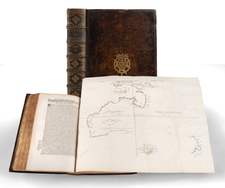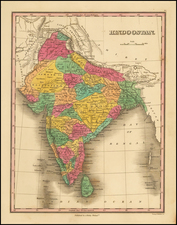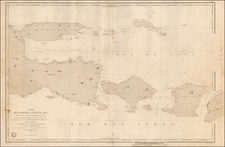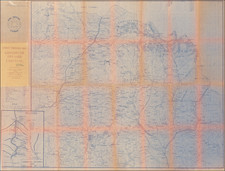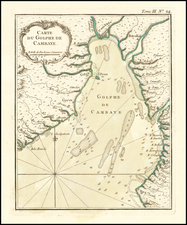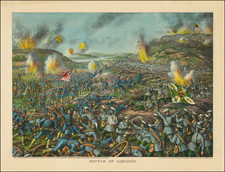The Earliest Obtainable Map To Show Houtman's Crossing of the Indian Ocean to the Java, Opening The Spice Trade to The Dutch in 1597.
Finely engraved map, showing the route of first Dutch fleet from Zuider Zee to Java in 1596-97, under the command of Cornelis De Houtman.
Rare De Bry edition of Cornelisz Claesz's map of the area extending from Africa to Southeast Asia and Northern Austalia, centered on India and the Indian Ocean.
De Bry's map is an early re-issue of a rare map of Africa and the Atlantic and Indian Oceans, designed to illustrate the first Dutch expedition to Java undertaken by Cornelis de Houtman, 1595-1597. Houtman's route of the voyage is indicated.
The pioneer voyage by the Dutch to Southeast Asia took place in the years 1595-97, under the leadership of Cornelis De Houtman. He established several commercial relations, e.g. with the great pepper port of Banten on the north west coast of Java, near which the Dutch colony of Batavia would soon be founded.
This expedition gave Holland first-hand data about the Sunda Strait, the northern coast of Java, and the island of Bali. News of this voyage was related in several works. Most important was the Historie van Indien, published by Cornelis Claesz in 1598. The book was supposed to contain a new general map of Southeast Asia, but the map was suppressed.
The suppressed map was published by Claesz later the same year as a loose-sheet, and a year later, de Bry published the account of the voyage together with a general overview map and other maps. This map shows the route of the Dutch across the Indian Ocean to Java and back.
Theodor de Bry (1528-1598) was a prominent Flemish engraver and publisher best known for his engravings of the New World. Born in Liege, de Bry hailed from the portion of Flanders then controlled by Spain. The de Brys were a family of jewelers and engravers, and young Theodor was trained in those artisanal trades.
As a Lutheran, however, his life and livelihood were threatened when the Spanish Inquisition cracked down on non-Catholics. De Bry was banished and his goods seized in 1570. He fled to Strasbourg, where he studied under the Huguenot engraver Etienne Delaune. He also traveled to Antwerp, London, and Frankfurt, where he settled with his family.
In 1590, de Bry began to publish his Les Grands Voyages, which would eventually stretch to thirty volumes released by de Bry and his two sons. The volumes contained not only important engraved images of the New World, the first many had seen of the geographic novelties, but also several important maps. He also published a collection focused on India Orientalis. Les Grands Voyages was published in German, Latin, French, and English, extending de Bry’s fame and his view of the New World.
Cornelis de Houtman was a Dutch explorer who discovered a new sea route from Europe to Indonesia and who thus begun the Dutch spice trade. At the time, the Portuguese Empire held a monopoly on the spice trade. Houtman was also a spy, having worked against the Portuguese by bringing back to the Netherlands privileged nautical information obtained during his stay in Portugal.
In 1592 Cornelis de Houtman was sent by Amsterdam merchants to Lisbon to discover as much information on the Spice Islands as he could. Portugal and Spain, then united, had closed their ports to Dutch ships in 1585, during the Eighty Years' War. Houtman spent about two years in Portugal. While his official work supported the Portuguese explorations in Southeast Asia, he surreptitiously gather information for the Dutch. Houtman returned with important and previously secret information about the seas and lands of the East: the coasts, the reefs and skerries, the sea currents, the winds, landmarks, local birds, friendly and enemy foes and about the strengths and weaknesses of the Portuguese.
At the same time he returned to Amsterdam, Jan Huygen van Linschoten returned from India. The merchants determined that Bantam (Banten) provided the best opportunity to buy spices. In 1594, the two merchants founded the company 'compagnie van Verre' (meaning "the long-distance company"), and on April 2, 1595 four ships left Amsterdam: the Amsterdam, Hollandia, Mauritius and Duyfken.
Troubles began immediately. By the time the expedition reached Madagascar, 70 sailors had died from scurvy. The ship arrived in Banten, Java in June 1596, just west of the modern city of Jakarta. Jan Huyghen van Linschoten had warned in advance not to pass through Portuguese controlled Malacca Strait, but instead to seek passage through Sunda Strait.
Houtman was introduced to the Sultan of Banten, who promptly entered into an optimistic treaty with the Dutch, writing "We are well content to have a permanent league of alliance and friendship with His Highness the Prince Maurice of Nassau, of the Netherlands and with you, gentlemen." Unfortunately, Houtman was undiplomatic to the sultan, and was unable to buy spices at all.
Houtman next sailed to Madura, but was attacked by pirates. In Madura, they were received peacefully, but Houtman ordered his men to seek revenge for piracy against the local inhabitants. The expedition next sailed for Bali, and met with the island's king. They managed to obtain a few pots of peppercorns on February 26, 1597. Two of the crew members stayed on the island. At Bawean, the Amsterdam was purposely set on fire, and the crew divided over the other three ships. It was decided not to go to the Moluccas and return to Holland. That evening another one of the skippers died. De Houtman was accused of poisoning him.
While the expedition was a humanitarian disaster and financially probably just broke even, it was a symbolic victory, breaking the Portuguese strangehold on trade in the region. Soon, the Dutch would fully take over the spice trade in and around the Indian Ocean.
On his second trip to the East, Houtman and his troops got into a confrontation in Aceh, because of his rude temperament, and soon there were fierce battles with the Acehnese Navy, led by Aceh's female admiral, Keumalahayati (Malahayati) who eventually managed to kill Cornelis de Houtman. Because of that incident, Queen Elizabeth I of England decided to send an emissary to the Sultan of Aceh, asking permission to enter Malacca Strait.










